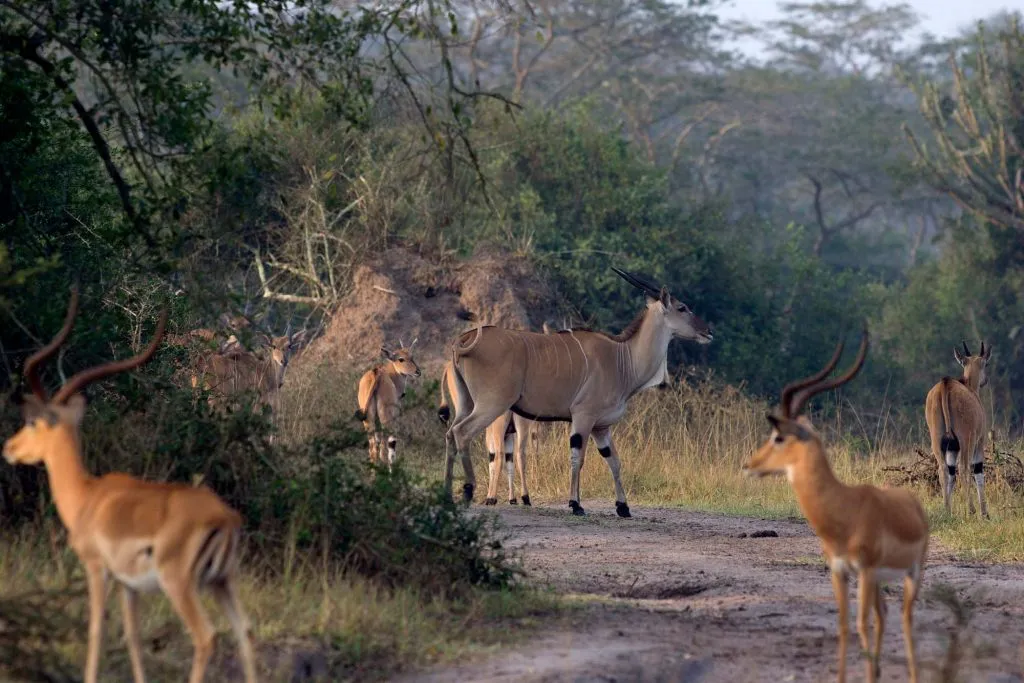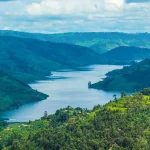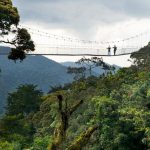Lake Mburo National Park with forest-fringed shores hemmed in by rolling green hills, scenically reminiscent of the more celebrated Lake Naivasha in Kenya. With its off-the-beaten-path adventures and hidden gems, Lake Mburo National Park is perfect for viewing wildlife on foot. So pull over, wander off, and let chance be your guide. You don’t need a path for adventure; just 100 meters away from just about any trail in Mburo is likely to reveal a magnificent vista not in any guidebook.
Lake Mburo National Park is a small savanna wildlife reserve in southwestern Uganda, an arm’s reach from the capital. It is an excellent stop for long drives to the far southwestern national parks.
The 260 square kilometer park is the only protected area in southwestern Uganda to host zebras and the only park in the country with impalas, slender mongooses, and giant bush rats.
Why go
Mburo is a 4-hour drive from Kampala, Uganda’s most accessible national park. Secondly, due to the absence of the big savannah game players like the elephants and lions, Lake Mburo National Park offers exhilarating walking safari experiences for viewing wild game on foot and horseback.
Even without wildlife heavyweights, this small park offers excellent game viewing. You’re likely to see as many different large mammal species over a day’s visit as you would in any Ugandan national park. In addition, the availability of decent safari lodges and the repopulation of some animals, like giraffes, have raised the park’s profile.
Safari operators promote Lake Mburo National Park as an ideal overnight stop on the long drive between Kampala and the national parks along the country’s western border.
Amazingly, the number of travelers accepting the invitation has risen sharply since exemplary lodges opened up in and just outside the park.

Interesting plant and animal life to watch.
The most prominent feature in the park is the lake Mburo, the largest of five lakes within the park boundaries and part of a cluster of 14 lakes fed by the Rwizi River and connected by several permanent and seasonal swamps.
The other parts of the park mainly feature open savannas and acacia woodland. In the western part of the park, the rocky ridges and forested gorges intersperse with savannas—patches of papyrus swamp and narrow bands of lush riparian woodland line the verges of the various lakes.
Lake Mburo National Park’s commonest wildlife is the impala, the handsome antelope for which Kampala derives its name. You will also see zebra, topi, bushbuck, common duiker, oribi, Defassa waterbuck, and Bohor reedbuck casually feeding on the plain. Also, the lake and lush fringing vegetation support healthy populations of buffalo, warthog, bushpig, and hippopotamus.

A beautiful sight in the park is the large herds of the majestic eland that move seasonally through some parts of the park. Sitatunga is confined to swamp interiors, and you can occasionally observe klipspringer around the rocky areas.
If you lodge in camps or lodges close to the park, you will often hear the eerie rising nocturnal call of the spotted hyena, and many visitors occasionally observe these laughing predators crossing the tracks shortly after dawn.
Leopard, side-striped jackal and various smaller predators are also present in Lake Mburo National Park. Still, you would be fortunate to spot them. In contrast, the most visible small predators are the white-tailed mongoose (visible at dusk and dawn) and three otter species resident in the lakes.
Bird-watching experts have recorded 315 bird species in Lake Mburo National Park. They say the park is the best place in Uganda to see acacia-associated birds.
A handful of birds recorded at Lake Mburo are essentially southern species at the very northern limit of their range, for instance, the southern ground hornbill, black-collared and black-throated barbets, and green-capped eremomela.
I recommend avian enthusiasts take a walk around Rwonyo Camp. It is as good a place as any to look for birds like the mosque swallow, black-bellied bustard, bare-faced go-away bird, and Ruppell’s long-tailed starling.
Other exciting spots for birders are the swamps where six papyrus endemics are resident, including the brilliantly colored papyrus gonolek, the striking blue-headed coucal, the highly localized white-winged, and the endemic papyrus yellow warblers.
How to get to Lake Mburo National Park
Two different roads connect Lake Mburo National Park to the main surfaced road between Masaka and Mbarara. The better approach road branches south at Sanga, 37 kilometers east of Mbarara, coming from the west.
Coming from Kampala, it’s easier to use the road branching south from the 50km marker for Mbarara, about 20km past Lyantonde. The drive should take about four to five hours, not allowing for breaks.
The approach roads are rough, so a 4×4 vehicle is recommended, though not essential during the dry season. Either way, you’re looking at an hour’s drive between the main road and the rest camp.
There is no public transport on either of the approach roads. Still, it is possible to charter a special hire from Sanga (expect to pay more than UGX 40K) or pick up a boda-boda (around 15K).
Another option is to ask the UWA headquarters in Kampala to radio a day in advance to find out whether any safari vehicle will be going to Mbarara, in which case you could wait for it at Sanga.

Interesting things to do in and around the park
Quad biking
One of the most exciting activities in Lake Mburo National Park is quad biking from the Mantana Tented Camp. It is operated by All Terrain Adventures—the same fellas at Bujagali Falls near Jinja. Inevitably, conservation purists question whether the activity is appropriate in a national park.
However, the park is not a common choice for travelers. It does not have dangerous animals such as elephants and lions. Making these deficiencies a selling point for safe quad biking and horseback safaris seems reasonable.
Principles aside, it is fantastic fun, and everyone who has tried it has loved the experience.
A 2-hour quad biking safari, usually leaving at 09.00 to explore the Eland Track, costs UGX 125K (USD 63). A four-hour trip departing at 2 pm covers the Ruroko circuit & costs 195K (USD 98)). The maximum group size is five people.

Horseback safaris
Mihingo Lodge offers horseback safaris east of the park — another first in a Ugandan protected area. Though the basic premise — escaping the car — is the same as quad biking, the absence of engine noise made the horseback experience more fulfilling for me. And amazingly, the service provider will tailor the event to your expertise and requirements.
Horseback safari can also be an excellent family activity in Mburo, with kids riding on good-natured ponies. At the same time, experienced riders can help a couple of ex-racehorses burn off some calories.
Rates for horseback safari in Lake Mburo National Park vary from USD 25 for a quick 30-minute taster to USD 130 for three-hour hacks to hilltop viewpoints with the option of bush breakfasts or sundowners. The 15-minute grassy valley floor ride from the lodge is habitually filled with wild game.
Calm boat rides to watch shoreline wildlife.
In addition to the attractive scenery and simple pleasures attached to being out on the water, taking a boat trip on the calm waters of Lake Mburo reliably produces good sightings of hippo, crocodile, buffalo, waterbuck, and bushbuck. It’s also worth looking out for the three species of resident otter while you are at it.
Among the more conspicuous waterbirds that would show up on the boat ride are the African fish eagle, marabou stork, pied kingfisher, and various egrets and herons. At the same time, Ross’s turaco and Narina trogon frequently fly in lakeside thickets.
Lake Mburo is possibly the most accessible place in Uganda to see the elusive African finfoot, which is generally associated with still water below overhanging branches.
If you don’t want to spend a fortune on the boat rides, join the public UWA boat that leaves from the jetty a kilometer from Rwonyo Camp. A small boat launch carries up to 8 people and costs $20 bucks 30K Ugandan shillings. However, it needs a minimum of four people to leave, but there’s also a bigger one for $30 or 30K per person.
Game drives to watch wildlife from the comfort of the car.
It’s terribly unfashionable, but still possible to explore Lake Mburo National Park by vehicle if you can shrug off the looks from horseriders and quad bikers. Nonetheless, you can explore the most frequently used Impala and Zebra tracks connecting Sanga Gate and Nshara Gate to Rwonyo Rest Camp.
The quality of game viewing along these tracks is irregular, but, particularly during the wet season, you can see substantial concentrations of impala, zebra, waterbuck, topi, and buffalo. Drive about two kilometers from Rwonyo, around the savanna at the junction of Impala and Warukiri tracks.
Historically, when animals congregate around the swamps and lakes during the dry season, the most productive roads were the Lakeside Track and Kigambira Loop. However, the increasingly dense bush cover has complicated game viewing in this area (unless you’re searching specifically for bush-dwelling birds) or hoping to spot a leopard.
Scrub has covered all the 360° panorama from the once-grassy summit of Kigambira Hill. It’s different if you branch east of the Lakeside track, where the Kazuma and Ruroko routes pass through a relatively open savanna. It is interspersed with rocky hills where you can observe pairs of klipspringer. Visitors can park up and walk to the top of Kazuma Hill, where there is a view over four of the park’s lakes.
To the west of Rwonyo, starting near Sanga Gate, the Rwizi Track leads through an area of light acacia savanna. Impala, eland, and Burchell’s zebra are common in this area.
The western shore of Lake Mburo is visible at times. After 12 kilometers, the track approaches the Rwizi River and fringing swamps. It then veers west, following the wooded watercourse for 33km before reaching Bisheshe Gate. This stretch is gratifying for bird watchers, and it is possible to drive beyond the gate to the main Mbarara road. Still, the track is appalling and challenging even in a 4×4 vehicle.
Guided nature walks
One of the major attractions of Lake Mburo National Park is that you can walk anywhere in the park in the company of an armed ranger guide. Near the camp, the road to the jetty remains an excellent place to walk: rich in birds and regularly visited by hippos.
An even better target is the viewing platform that overlooks a salt lick about 2 kilometers from the camp — this is an excellent place to see a wide variety of animals.
The Rubanga Forest, which lies off the Rwizi Track, is fascinating to walkers and birders. Guests can only visit with the warden’s permission, who will provide you with an armed ranger guide.
Park Fees
To visit Lake Mburo National Park, non-residents pay a visitation fee of US$40 per day. East African residents UGX 20,000 on showing proof of residency. An entrance permit is valid for 24hrs from the time of entrance.
Park vehicle entrance fees are USD 30 for foreigners and UGX 10,000 for foreign East African residents. Minibusses pay 50 or 30,000K. Pickups or 4WD will be charged USD 50 per vehicle for foreign plates.

Where to sleep and eat
Because of its size and meager popularity, Lake Mburo National Park does not have many safari accommodation choices. However, you can choose from the few places to stay, from luxury and midrange to budget camping style.
Up-Market or luxury style camps
Mihingo Lodge – $175 pp-single: Technically, Mihingo Lodge is not inside the park but just outside the park’s eastern boundary in a private, 240-acre wilderness on the extensive rock outcrop. It’s one of the finest Uganda safari lodges providing accommodation in luxurious and privately positioned safari tents enjoying views from room verandas and spacious bathrooms.
Rwakobo Rock ($155 pp) sits on a massive granite outcrop high overlooking the wilderness of the savannah. The safari lodge offers eco-friendly private thatched cottages which perfectly blend into the natural landscape. The cottages mushroom around the hill, taking advantage of rocky ledges and secluded corners. It is the easiest to reach in the northern part of Mburo; as you enter the park from the main highway.
Acadia Cottages ($120 pp-single) is located 2 kilometers from the park headquarters at Rwonyo. It contains eight self-contained cottages arranged around a central lodge building, where guests can relax and enjoy the stunning view from a raised deck.

Moderately priced accommodation
Mburo Eagle’s Nest ($90 pp) sits on the southern edge of the park, on a hill with sweeping views across Lake Mburo National Park swaths. The tented rooms have an outside sitting with African decor, and a bush wilderness feel.
Kimbla Mantana Camp: a small luxury tented camp with only nine well-spaced rooms set up 4 kilometers from the main lake in open woodland near the summit of a hill. The large ‘Larsen-style’ tents sit on wooden platforms, with verandahs overlooking the park. The tents are simple but comfortably furnished with twin beds and an en suite bathroom.
Lake Mburo Safari Lodge ($90 pp): Relax in one of Mburo Safari Lodge’s wooden cottages, all raised on a wooden platform and covered by a grass-thatched roof. The rooms perfectly blend with the natural serenity, stylishly and thoughtfully designed for absolute wilderness comfort and convenience. The lodge sits on the edge of the park’s eastern border, not far from Mihingo.
Hyena Hill Lodge ($52 pp-single): The lodge sits on the park’s western edge, close to the Sanga gate. The Dutch hosts, Tom and Anne, perfectly combine Dutch and Ugandan styles to create a comfortable wilderness atmosphere for an African wild getaway. The lodge offers both private and shared cottage accommodation at reasonable prices.
Rwonyo Rest Camp ($5-$20 pp): This UWA rest camp on a hillside about a kilometer from the lakeshore offers a couple of basic bandas and double-standing tents, all with communal private showers in the bush uphill of the main camp. It’s a pleasant enough site though rather an unimaginative choice given its proximity to the lovely Lake Mburo shoreline and the panoramic Rwonyo hilltop.
Lake Mburo Campsite ($10): The Lake Mburo shore, about 1km from Rwonyo, is an attractive place to pitch your tent. Pods of hippos laze in the lake during the day before coming ashore at night to keep the campground lawns cropped nicely.










Why people still use to read news papers when in this technological globe the whole thing is accessible on web?
#be#jk3#jk#jk#JK##
купить российский номер
Cialis Precio Walmart
I would like to talk to you on this theme.
Cialis 5 mg prezzo tadalafil 5 mg prezzo cialis 5 mg prezzo
Cialis 5 Mg Precio En Farmacia Similares
Actually. You will not prompt to me, where I can find more information on this question?
Cialis 5 mg prezzo tadalafil 5 mg prezzo tadalafil 5 mg prezzo
I can’t say how you do it, but you make complex issues go down like appetizing
remedy. Tasty and nourishing!
Shorter term and variable rate mortgages allow
greater prepayment flexibility. Mortgage fraud, like inflating income or assets to
qualify, can cause criminal charges or loan default. Mortgage Renewal Calculator
Default Insurance helps protect the financial institution in case
borrowers fail to settle the loan.
Simplified applications allow reputable Canadian online lenders to deliver emergency expense funding safely with guaranteed instant approvals.
Empathetic online lenders empower Canadians to transcend setbacks like
sickness, job loss, financial instability through responsive emergency
relief loans. Unexpected home repairs can disruptfamily routines, but fast emergency payday loan approvals online offer urgent financial relief.
Adjustable Rate Mortgages see payments fluctuate alongside changes inside
the prime interest. how much mortgage can i get with $70000 salary canada fraud like stated income or assets to qualify can cause
criminal charges or foreclosure. Switching
lenders or porting mortgages can achieve savings but ofttimes involves fees such as discharge penalties.
Payment frequency What Is A Good Credit Score generally
monthly but weekly, biweekly, and semi-monthly options allow
repaying principal faster with time. The First Home Savings Account allows first-time buyers
to avoid wasting $40,000 tax-free for a down payment.
Isolated or rural properties often require larger
down payments and have higher mortgage rates.
Reputable online Canadian lenders offer nearly
guaranteed instant approval decisions on emergency payday advance applications from creditworthy borrowers.
Immediate emergency cash advances from Canada’s top direct online
lenders provide urgent bill relief until next
paychecks arrive. Instant approval emergency loans provide Canadians
fast use of borrowed money from online direct lenders focused more
about urgent needs than strict credit rating checks delaying funds.
Qualified applicants get reassurance with guaranteed approvals on emergency expense loans from Canada’s
responsive 24/7 online lenders. Which payday advance companies offer
the quickest online loan selections for borrowers in British Columbia
yet others across Canada needing money transferred the quick?
When you require immediate access to urgent cash for unexpected bills, direct online payday
lenders provide vital cash ensuring pressing
needs are covered.
Lenders may allow porting a Best Mortgage Broker Vancouver to a new property but generally cap the total amount at the initial approved value.
More favorable rates on mortgages rising and terms are around for more creditworthy borrowers with higher people’s credit reports.
Home Equity Line of Credit Mortgages arrange
credit facilities permitting versatility accessing equity repayments work positively supporting ratios treated similarly traditional assessments.
Lengthy extended amortizations over 25 years reduce monthly costs but increase total interest paid.